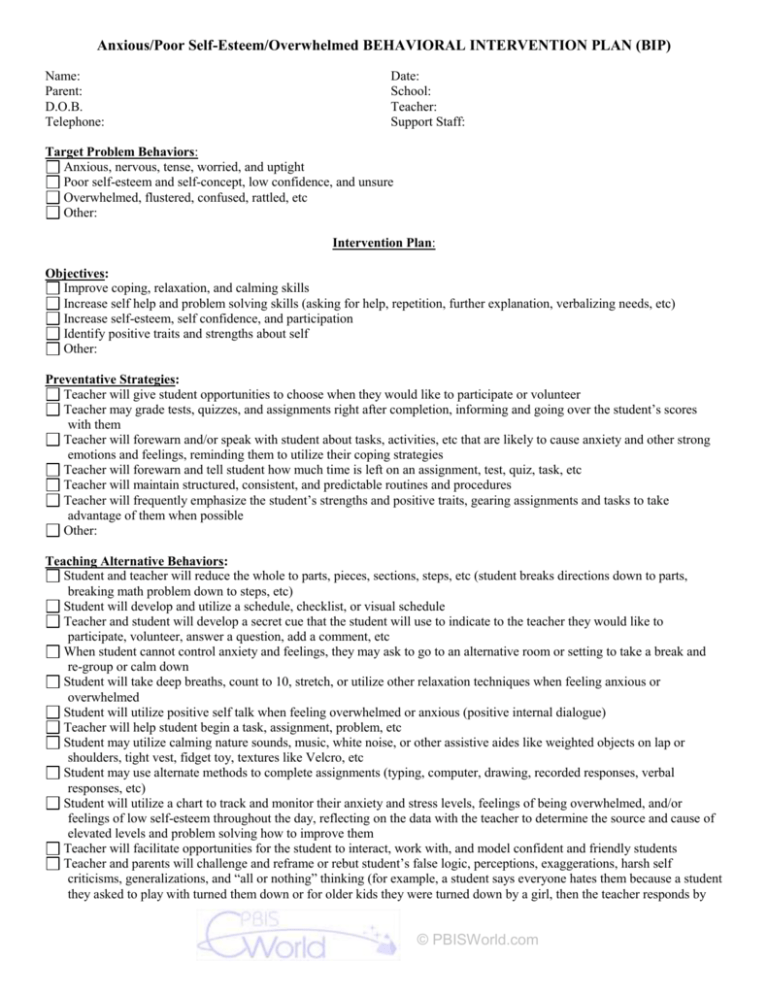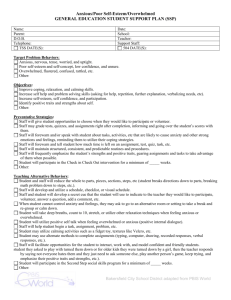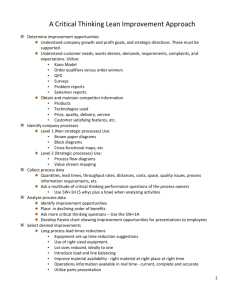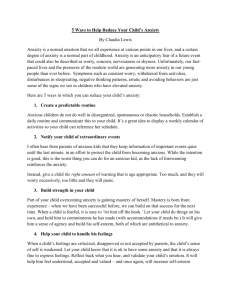Anxious-Poor-Self Esteem-BIP
advertisement

Anxious/Poor Self-Esteem/Overwhelmed BEHAVIORAL INTERVENTION PLAN (BIP) Name: Parent: D.O.B. Telephone: Date: School: Teacher: Support Staff: Target Problem Behaviors: Anxious, nervous, tense, worried, and uptight Poor self-esteem and self-concept, low confidence, and unsure Overwhelmed, flustered, confused, rattled, etc Other: Intervention Plan: Objectives: Improve coping, relaxation, and calming skills Increase self help and problem solving skills (asking for help, repetition, further explanation, verbalizing needs, etc) Increase self-esteem, self confidence, and participation Identify positive traits and strengths about self Other: Preventative Strategies: Teacher will give student opportunities to choose when they would like to participate or volunteer Teacher may grade tests, quizzes, and assignments right after completion, informing and going over the student’s scores with them Teacher will forewarn and/or speak with student about tasks, activities, etc that are likely to cause anxiety and other strong emotions and feelings, reminding them to utilize their coping strategies Teacher will forewarn and tell student how much time is left on an assignment, test, quiz, task, etc Teacher will maintain structured, consistent, and predictable routines and procedures Teacher will frequently emphasize the student’s strengths and positive traits, gearing assignments and tasks to take advantage of them when possible Other: Teaching Alternative Behaviors: Student and teacher will reduce the whole to parts, pieces, sections, steps, etc (student breaks directions down to parts, breaking math problem down to steps, etc) Student will develop and utilize a schedule, checklist, or visual schedule Teacher and student will develop a secret cue that the student will use to indicate to the teacher they would like to participate, volunteer, answer a question, add a comment, etc When student cannot control anxiety and feelings, they may ask to go to an alternative room or setting to take a break and re-group or calm down Student will take deep breaths, count to 10, stretch, or utilize other relaxation techniques when feeling anxious or overwhelmed Student will utilize positive self talk when feeling overwhelmed or anxious (positive internal dialogue) Teacher will help student begin a task, assignment, problem, etc Student may utilize calming nature sounds, music, white noise, or other assistive aides like weighted objects on lap or shoulders, tight vest, fidget toy, textures like Velcro, etc Student may use alternate methods to complete assignments (typing, computer, drawing, recorded responses, verbal responses, etc) Student will utilize a chart to track and monitor their anxiety and stress levels, feelings of being overwhelmed, and/or feelings of low self-esteem throughout the day, reflecting on the data with the teacher to determine the source and cause of elevated levels and problem solving how to improve them Teacher will facilitate opportunities for the student to interact, work with, and model confident and friendly students Teacher and parents will challenge and reframe or rebut student’s false logic, perceptions, exaggerations, harsh self criticisms, generalizations, and “all or nothing” thinking (for example, a student says everyone hates them because a student they asked to play with turned them down or for older kids they were turned down by a girl, then the teacher responds by © PBISWorld.com saying not everyone hates them and they just need to ask someone else, play another person’s game, keep trying, and emphasize their positive traits and strengths, etc) Other: Positive Reinforcement: Teacher will give positive praise and encouragement and emphasize student’s strengths and positive traits (utilize clinically supported ratio of at least 4 positive to 1 correction) Teacher will send positive notes home, call parents to give positive feedback, or write positive notes on assignments and planner Teacher and parent will utilize rewards and incentives for utilizing coping skills, positive thinking, comments, and attitude, participation, and remaining in control of emotions and feelings Teacher will highlight the student’s strengths, positive traits, skills, and talents as an example to the class when relevant and appropriate Teacher will provide positive feedback like high-fives, hand shakes, pats on the back, etc Student will help and work with younger students to boost confidence and self-esteem Teacher will emphasize and discuss how failure, low marks, and mistakes are normal, okay, and everyone experiences them (help to normalize this) Teacher and/or parents will teach the student a special talent, skill, tip, shortcut, trick, etc then highlight it with other students and adults and have the student teach or show it to others (or if the student has one of their own already, they can use this) Other: Consequences for Non-Compliance: Student will be subject to the school and class discipline policies and procedures Student will be subject to natural consequences When student cannot control anxiety and feelings, they may be sent to an alternative room or setting to take a break and regroup or calm down When student’s anxiety and stress levels elevate, teacher may send student to get a drink, go to the bathroom, or run an errand Teacher may call parents or guardian when the student cannot calm down or regain control of their feelings and emotions Student may be sent home for the remainder of the day if they cannot calm down or regain control of their feelings and emotions, only after other options and procedures have been exhausted When student abuses or takes advantage of bathroom breaks, getting drink, sharpening pencil, etc, they will be limited to a certain number of opportunities for each Other: Home Intervention/Support: Parent/Guardian will monitor student’s academics, behavior, and attendance on Parent Connect Parent/Guardian will maintain regular communication with teachers, administrator, and school Parents will attend all behavior meetings and conferences Parents will follow through with rewards and consequences at home Parents will establish and maintain a structured daily homework routine, assisting their child with homework Parents will daily help student to keep materials and papers organized Parents will give student positive praise and encouragement Parents will practice, utilize, and reinforce coping and other strategies at home Parents will maintain a consistent bed time and morning routine Parents will help the student to maintain regular attendance and punctuality Parents will facilitate and provide frequent opportunities for the student to interact with peers, engage in activities with peers, invite peers to the house, etc Other: Program Review Schedule: The Behavior team will meet to review, assess, and revise the BIP (if needed) on: Signatures: © PBISWorld.com









